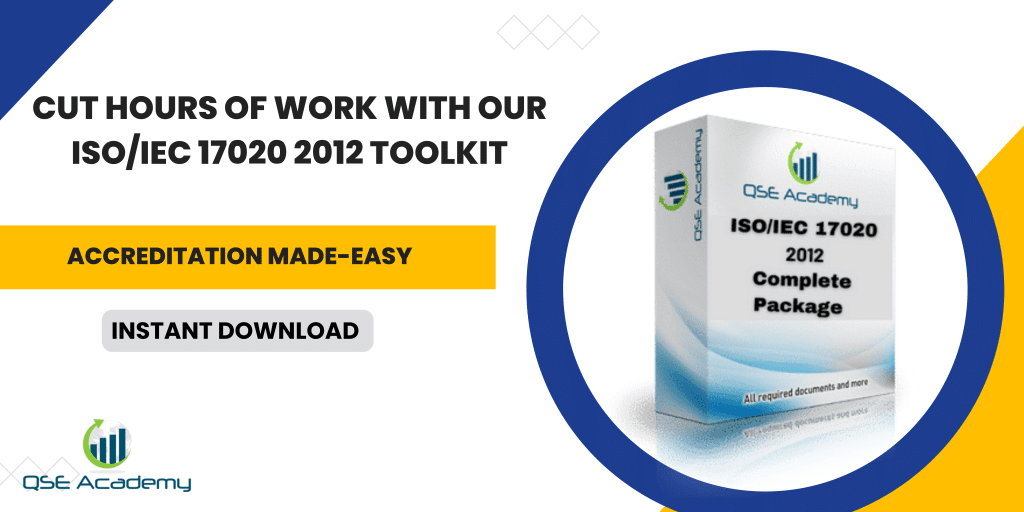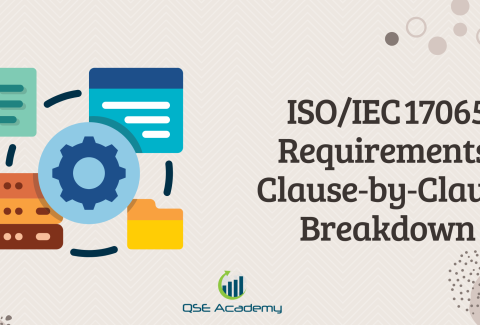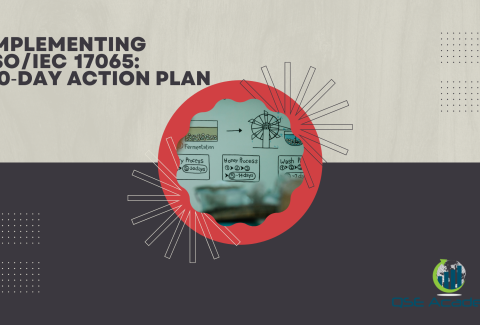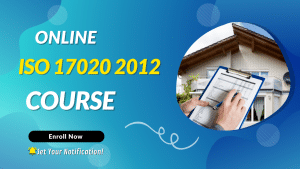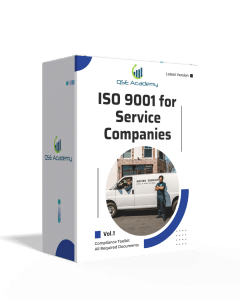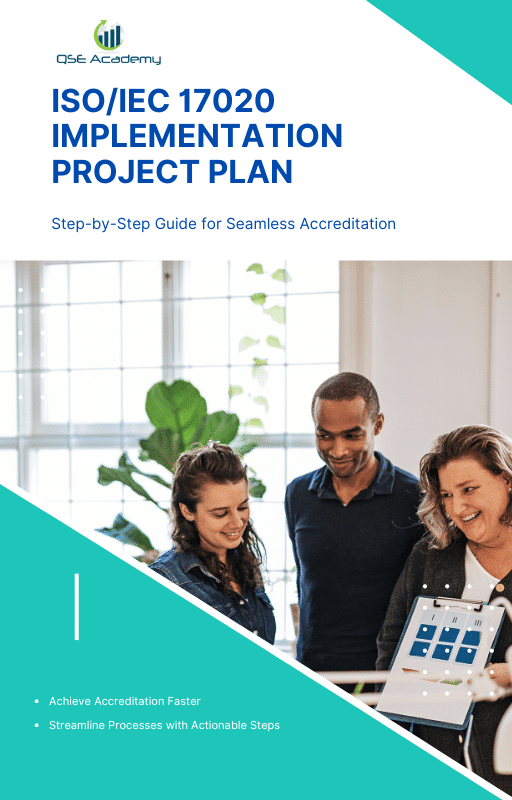Implementing ISO/IEC 17020: 90‑Day Action Plan
Last Updated on October 22, 2025 by Hafsa J.
A 90-Day Roadmap to ISO/IEC 17020 Compliance
Implementing ISO/IEC 17020 can feel overwhelming at first. There are clauses to interpret, documents to write, and auditors to prepare for—all while running your inspection business day-to-day. Most organizations know why they need accreditation. The real challenge is figuring out how to get there efficiently, without dragging the process out for a year.
This pillar guide gives you a clear, structured 90-day roadmap to build a compliant, audit-ready inspection management system. It walks you through each step—from planning and gap analysis to documentation, competence, audits, and accreditation readiness—showing you what to do, when to do it, and how to stay on track.
I’ve designed this plan for real-world teams: small or mid-sized inspection bodies with limited resources, tight schedules, and a strong desire to achieve ISO/IEC 17020 accreditation quickly but correctly.
You’ll see what milestones to hit every few weeks, where to focus effort for the highest impact, and how to maintain momentum so your system matures naturally by Day 90.
This isn’t theory—it’s a practical action plan built from years of experience helping inspection bodies reach accreditation without confusion, burnout, or unnecessary cost.
By the end, you’ll know exactly what to prioritize, how to pace your implementation, and what “audit-ready” truly looks like.
Before You Start – Building a Strong Foundation for Implementation
Before diving into the 90-day plan, take a moment to set the groundwork. ISO/IEC 17020 implementation isn’t just about writing documents; it’s about building a system that fits your organization’s real operations. The first few days are crucial because they define how smooth—or painful—the next three months will be.
Start with three essentials: management commitment, scope clarity, and defined responsibilities.
Management Commitment
Your leadership team needs to be fully on board. Accreditation demands time and focus, so everyone—from top management to inspectors—must understand why ISO/IEC 17020 matters and how it strengthens credibility, client trust, and competitiveness.
Have leadership formally approve the project and allocate time for system development, internal audits, and reviews. A simple memo or meeting note showing management support already meets part of Clause 8.1.
Define Your Inspection Scope
Be specific. Clearly describe what your inspection body does—what type of inspections, for which clients, and under what conditions. Your entire management system will revolve around this scope, so vague definitions only create confusion later.
If you offer multiple types of inspections, start with one core service and expand after accreditation. Narrow focus speeds up success.
Assign Roles and Responsibilities
Even in a small team, define who’s doing what. Typical key roles include:
-
Project Lead / Quality Manager: Oversees the implementation and ensures deadlines are met.
-
Technical Manager: Ensures inspection methods and technical competence meet requirements.
-
Internal Auditor: Conducts internal audits and verifies system effectiveness.
Pro Tip: Keep the team lean—three to five focused people are ideal. Too many voices slow progress.
With leadership commitment, a clear scope, and assigned roles, your foundation is set. The next phase—your first 30 days—will focus on identifying what’s missing and structuring your system for compliance.
Phase 1: Weeks 1–4 – Gap Analysis and System Setup
The first month is all about understanding where you stand and building the structure for everything that follows. Think of this phase as your blueprint stage—you’re not constructing the house yet, but you’re laying the foundation that keeps it from collapsing later.
Your goal for these four weeks is simple: identify gaps, organize your current processes, and set up the framework of your ISO/IEC 17020 management system.
Step 1: Conduct a Practical Gap Analysis
Start by comparing your current operations to ISO/IEC 17020 requirements.
Ask three key questions for every clause:
-
Do we already do this?
-
Is it documented?
-
Can we show evidence?
Create a simple spreadsheet with columns for Clause, Current Status, Action Needed, and Responsible Person. It doesn’t need to be fancy—clarity is what matters.
By the end of this step, you’ll have a list of what’s already compliant, what needs minor tweaks, and what’s completely missing.
Step 2: Map and Organize Existing Documents
Gather your existing procedures, forms, and records—inspection reports, safety checklists, calibration certificates, client communication templates.
Label them and sort them into folders (physical or digital) by category.
This exercise often reveals that you already meet several clauses without realizing it.
Pro Tip: Don’t overthink structure. A basic folder system named by clauses—like “Clause 4 Impartiality” or “Clause 7 Inspection Methods”—is enough at this stage.
Step 3: Establish Document Control
Once your documents are mapped, decide how you’ll manage them going forward.
Set a simple rule: every document must have a version number, approval date, and owner.
Use Word, Excel, or Google Drive—you don’t need special software.
Step 4: Draft Key Foundational Policies
Two documents are essential before moving forward:
-
Impartiality and Independence Policy (Clause 4)
-
Organizational Structure and Roles (Clause 6)
Keep them straightforward. A one-page impartiality statement and a simple organization chart can meet the requirement.
By Day 30, you should have:
-
A completed gap analysis.
-
A functioning document-control system.
-
Your impartiality and management structure policies in place.
This phase doesn’t require perfection—it’s about clarity. Once you know your starting point, you can move confidently into building your actual management system in the next phase.
Phase 2: Weeks 5–8 – Documentation and Training
Now that your system framework is in place, it’s time to build the core — your documented procedures and trained, competent team. This is where your management system takes shape. Everything you create in this phase will become the foundation for your future audits and day-to-day operations.
Your two main priorities: write what you do, and train your people to do it consistently.
Step 1: Develop Essential Procedures
Start with the minimum set required to demonstrate control and consistency. Focus on:
-
Document Control Procedure – how you create, approve, and revise documents.
-
Impartiality Management Procedure – how you identify and prevent conflicts of interest.
-
Competence & Training Procedure – how you qualify and authorize inspectors.
-
Inspection Procedure(s) – your step-by-step inspection process for each service type.
-
Internal Audit & Corrective Action Procedure – how you check your own compliance and fix issues.
Write simply. Describe how you actually work, not how you wish you worked. Use your existing checklists and logs as inputs.
Pro Tip: Use modular documents — one topic per procedure. It keeps your system flexible as you grow.
Step 2: Build Forms and Records
Every procedure needs a way to record evidence. Create basic templates for:
-
Training records and competence matrix
-
Inspection report form
-
Corrective action form
-
Internal audit checklist
These don’t need logos or special formatting — clarity and traceability matter more than design.
Step 3: Train Your Team
Once your procedures are drafted, gather your team for focused sessions. Walk them through:
-
The purpose of ISO/IEC 17020
-
Their specific roles under each clause
-
How to use new forms and templates
Training doesn’t need to be formal or costly. Document every session — date, attendees, topic, and trainer — and you already have audit evidence.
Pro Tip: Turn practical work into training opportunities. For example, when conducting a mock inspection, review how reporting, impartiality, and calibration tie into ISO requirements.
Step 4: Validate Competence and Authorization
Before the internal audit, ensure each inspector’s competence is documented. A simple competence matrix listing staff names, training received, and authorized inspection types will satisfy most assessors.
By Day 60, you should have:
-
All key procedures written and reviewed.
-
Templates and records ready for use.
-
Your staff trained, authorized, and confident in their roles.
Your management system is now functional. The next step is to test how well it actually works — through internal audits and management reviews.
Phase 3: Weeks 9–12 – Internal Audit, Review, and Readiness
At this point, your ISO/IEC 17020 system is operational. You have procedures, records, and trained people. Now it’s time to confirm that everything works — and prove it through internal audits and management review. This final phase is where you shift from building to verifying.
Your goal for the next four weeks: evaluate, correct, and prepare for your external accreditation assessment.
Step 1: Plan and Conduct an Internal Audit
An internal audit is your rehearsal for the real thing.
Create an audit plan that covers all clauses — not all at once, but in logical groups (e.g., impartiality, competence, inspection methods, and management review).
Use your internal audit checklist and gather objective evidence: records, reports, training logs, calibration certificates.
Document everything — findings, observations, and corrective actions.
Even if no issues arise, record that you verified compliance.
Pro Tip: Have someone not directly involved in the process conduct the audit, if possible. Independence adds credibility to your results.
Step 2: Review Findings and Take Action
Go through every nonconformity or observation from the audit and assign actions.
Keep your corrective action form simple:
-
What was found?
-
Why did it happen?
-
What was done to fix it?
-
Who verified it?
Close each action with evidence (a revised form, updated procedure, or retraining record).
Step 3: Hold a Management Review Meeting
A management review isn’t a formality — it’s where leadership confirms the system’s effectiveness.
Keep it concise and evidence-based. Discuss:
-
Internal audit results
-
Client feedback
-
Nonconformities and corrective actions
-
Resource needs and improvement opportunities
Record the meeting minutes and action items. That single record fulfills a major clause (8.7) and shows ongoing commitment.
Step 4: Prepare for Accreditation
By the end of Week 12, gather all your documentation into one place:
-
Quality Manual or Policy
-
Procedures and templates
-
Training and competence records
-
Audit reports and corrective actions
-
Management review minutes
If everything is traceable and consistent, you’re ready to submit your application to the accreditation body.
Pro Tip: Do a short “mock audit” the week before submission. Walk through your records as if you were the assessor. It’s the best confidence boost you’ll get before the real thing.
Key Focus Areas That Make or Break Your 90-Day Plan
Even with a solid roadmap, some areas can quietly derail your implementation if overlooked.
These aren’t just technical clauses — they’re the backbone of ISO/IEC 17020.
When assessors visit, these are the areas they’ll examine most closely to decide whether your system is truly credible and sustainable.
Here’s what to get right from the start:
1. Impartiality and Independence (Clause 4)
This is non-negotiable. You must show that your inspection results are free from internal or external pressure.
Have a clear impartiality policy and a system for identifying and managing risks to objectivity.
Even small teams can demonstrate control — keep a log of potential risks and how they’re addressed (for example, staff declarations or review by a neutral manager).
Pro Tip: Review impartiality at least once a year during management review. It’s one of the simplest ways to prove continual oversight.
2. Competence and Authorization (Clause 6)
Every inspector must be competent and authorized for the work they perform.
Keep training records up-to-date and link them to actual inspection activities.
Auditors often ask: “Show me how you know this person is qualified.”
Your competence matrix, authorization letters, and training logs are your proof.
3. Inspection Methods and Reporting (Clause 7)
Your procedures must reflect how inspections are carried out in reality — not theory.
Describe each step clearly, including preparation, inspection, data recording, and reporting.
Attach sample reports to show traceability from inspection to result.
Common Pitfall: Borrowing procedures from another organization without adapting them. Assessors can tell immediately when documents don’t match your operations.
4. Corrective Actions and Continual Improvement (Clause 8)
ISO/IEC 17020 expects you to learn from mistakes, not hide them.
Log every nonconformity and improvement opportunity.
Show that issues are tracked, fixed, and verified.
Even minor improvements — like simplifying a checklist — demonstrate a living system.
These four areas determine whether your system feels real or just looks compliant.
If you control impartiality, competence, methods, and improvements consistently, everything else in ISO/IEC 17020 naturally falls into place.
Integrating with Existing Systems (ISO 9001 or ISO/IEC 17025)
If your organization already follows ISO 9001 or ISO/IEC 17025, you’re not starting from zero.
These standards share many principles with ISO/IEC 17020 — particularly around management systems, competence, and continual improvement.
Integration is about working smarter, not rebuilding everything from scratch.
Here’s how to align your systems without duplication or confusion.
1. Identify Overlapping Requirements
Start by mapping common clauses.
For example:
-
Document Control appears in all three standards.
-
Internal Audits and Corrective Actions follow the same logic.
-
Management Review focuses on system performance and improvement in each.
Once you identify the overlaps, unify the process.
You don’t need three different procedures — one well-structured version can meet all requirements simultaneously.
Pro Tip: Create a clause-correlation matrix showing how each ISO standard’s requirements are addressed in your integrated system. It’s simple to maintain and impresses assessors.
Keep shared processes centralized:
-
Use one document control procedure for all standards.
-
Run a single training and competence program that meets ISO/IEC 17020 and ISO/IEC 17025 requirements.
-
Combine corrective action and audit processes — they already use the same logic.
This reduces effort, improves consistency, and simplifies audits.
3. Maintain Technical Independence Where Needed
While integration brings efficiency, don’t merge everything blindly.
Inspection (ISO 17020) focuses on impartial judgment, while testing and calibration (ISO 17025) emphasize measurement traceability.
Keep technical controls separate where the intent differs.
Example: You can share document control but maintain distinct records for inspection reports and test results.
4. Use Combined Internal Audits and Management Reviews
One audit program can assess all standards at once, provided you include each set of requirements in your checklist.
Similarly, a single management review can evaluate the entire integrated system — with agenda items covering quality, impartiality, and technical competence.
Pro Tip: When scheduling audits or reviews, assign one lead coordinator to ensure no clause is missed across standards.
Integration streamlines your work, minimizes overlap, and reduces costs.
When done right, it also sends a clear message to assessors: your system isn’t just compliant — it’s cohesive, controlled, and efficient.
Implementing on a Small-Business Budget (Efficiency Tips)
Not every inspection body has a big team or deep pockets — and that’s perfectly fine.
ISO/IEC 17020 is designed to fit any organization’s size, as long as you can demonstrate control, competence, and impartiality.
The key is learning where to save and where to invest.
Here’s how to make implementation efficient, realistic, and cost-effective without cutting corners.
1. Use Free or Low-Cost Tools
You don’t need enterprise software to manage your quality system.
Free or affordable tools can handle most ISO/IEC 17020 requirements:
-
Google Workspace or Microsoft 365: Document control and version tracking.
-
Trello or Notion: Tracking tasks and clause responsibilities.
-
Excel or Google Sheets: Recording audits, KPIs, or corrective actions.
Pick one platform and stick to it — consistency is more important than sophistication.
Pro Tip: Keep one “ISO 17020 Master Folder” with subfolders by clause. It’s simple, searchable, and fully acceptable during assessments.
2. Focus Spending on Competence and Impartiality
Assessors pay attention to two things above all else — qualified personnel and independent decision-making.
Spend money where it truly matters:
-
Training inspectors and authorizing them for specific inspection types.
-
Establishing impartiality controls and external reviews if needed.
Everything else can be handled internally with good documentation and discipline.
3. Outsource Selectively, Not Completely
Hiring a consultant for everything defeats the purpose of a lean system.
Instead, outsource only where you need technical validation — for example, calibration, legal reviews, or an impartiality committee member.
Do the rest in-house so your team learns the system from the inside out.
Pro Tip: A one-day readiness review from an expert often saves thousands by catching issues before accreditation.
4. Build Slowly, Improve Continuously
If cash flow is tight, you can phase your implementation.
Start with the minimum required documents and records. Once accredited, expand your procedures as your operations grow.
ISO/IEC 17020 doesn’t demand size — it demands structure.
A smart budget is about direction, not dollars. When every step is documented, practical, and proven, your system earns respect because it works — not because it’s expensive.
Common Pitfalls During the 90-Day Implementation
Even with a clear plan, it’s easy to get sidetracked during implementation. Some teams move too fast and miss critical requirements; others overcomplicate simple steps and burn time unnecessarily.
Here are the most common pitfalls that can slow down or weaken your ISO/IEC 17020 project — and how to avoid them.
1. Over-Documenting Everything
It’s tempting to write a long procedure for every clause. But assessors don’t want volume — they want clarity.
If your team can’t follow a document easily, it’s not effective. Keep each procedure short, relevant, and true to how you actually operate.
Pro Tip: If you need more than two pages to explain a process, it’s probably two separate processes.
2. Ignoring Impartiality Risks
This is the number-one issue in early audits. Many small inspection bodies assume that because they’re independent, they’re automatically impartial. Not true.
You must show evidence — declarations, risk assessments, or impartiality reviews — to prove that inspections are free from bias.
Quick Fix: Schedule a 15-minute impartiality review every quarter and record the discussion. It shows active control.
3. Delaying Training Until the End
Some organizations focus on documents first and plan to train “once everything’s ready.” That approach backfires.
Training early helps your team understand procedures as they’re written — and avoids retraining later.
Pro Tip: Turn each procedure review into a short training session. Two goals achieved at once.
4. Treating Internal Audits as Paperwork
A checklist alone isn’t an audit. Assessors expect to see real evaluation — interviews, observation, and review of evidence.
Don’t just tick boxes. Record what was checked, who was interviewed, and what improvements were identified.
5. Rushing the Management Review
This step is more than a formality. It’s where leadership confirms that the system works and resources are adequate.
Skipping or rushing it tells assessors your system isn’t mature.
Pro Tip: Keep the first review short but meaningful. Discuss three things: internal audit results, nonconformities, and improvement actions. That’s enough to show real oversight.
Avoiding these pitfalls keeps your 90-day plan realistic, efficient, and credible.
Remember — it’s not about speed alone; it’s about building a system that’s lean, functional, and ready to perform under audit pressure.
FAQs – Common Questions About the 90-Day ISO/IEC 17020 Plan
Q1: Is it really possible to implement ISO/IEC 17020 in just 90 days?
Yes — if you follow a structured plan and dedicate consistent effort each week. Most small and medium inspection bodies already have the basic processes in place. The 90-day timeline simply helps you organize, document, and verify them in a focused way.
The secret isn’t rushing — it’s prioritizing what matters most: impartiality, competence, inspection methods, and management review.
Q2: How much time should the team commit each week?
Plan around 8–10 hours a week for system development, document writing, and internal audits.
If you’re a small team, divide tasks early — one person handles documentation, another focuses on competence records, and another leads audits. Clear roles prevent bottlenecks and make the timeline realistic.
Q3: Can we do it without a consultant?
Absolutely. Many inspection bodies achieve accreditation using internal resources, supported by reliable templates and structured guides.
A consultant can accelerate progress but isn’t required if your team understands the clauses and stays disciplined.
Pro Tip: Schedule a short external readiness review in Week 12 to double-check your work before the accreditation audit.
Q4: What’s the most common reason teams miss the 90-day goal?
They wait too long to start audits and reviews. Many organizations spend all their time writing procedures and forget that evidence of use matters more.
Start using your forms and checklists by Week 6 — not at the end. Assessors want proof that your system operates, not just exists on paper.
Q5: How do we know we’re truly “audit-ready”?
You’re ready when:
-
All clauses have documented and implemented evidence.
-
Internal audits and management review are completed.
-
Corrective actions are logged and closed.
-
Everyone on the team understands their roles.
If you can walk an assessor through your system confidently — without flipping through pages nervously — you’re audit-ready.
A well-executed 90-day plan doesn’t just prepare you for accreditation; it builds a system you can actually use and sustain.
Turning Your 90-Day Plan into Long-Term Success
Implementing ISO/IEC 17020 in 90 days isn’t about rushing — it’s about focus, structure, and momentum. When you break the process into clear, manageable steps, the path to accreditation stops feeling like an uphill climb and starts feeling like progress you can measure week by week.
In these three months, you’ve built the essentials: documented processes, trained and competent inspectors, an impartial and traceable inspection system, and management oversight that drives improvement. That’s not just compliance — that’s capability.
The organizations that sustain their accreditation long-term do one thing differently: they keep the rhythm. Internal audits, management reviews, and small improvements become part of everyday work, not last-minute tasks before an assessment.
Think of this 90-day plan as your launch pad. Once accredited, continue refining your system — update records regularly, review impartiality risks quarterly, and look for ways to make your processes leaner and more effective.
Final Thought:
ISO/IEC 17020 isn’t about perfection; it’s about proof — proof that your inspections are competent, consistent, and impartial.
When your team understands that principle and keeps improving one small step at a time, compliance turns into culture — and that’s where real quality lives.
Next Step:
Download the ISO/IEC 17020 90-Day Implementation Tracker or connect with QSE Academy to map your system against this framework and prepare confidently for your upcoming accreditation audit.
I hold a Master’s degree in Quality Management, and I’ve built my career specializing in the ISO/IEC 17000 series standards, including ISO/IEC 17025, ISO 15189, ISO/IEC 17020, and ISO/IEC 17065. My background includes hands-on experience in accreditation preparation, documentation development, and internal auditing for laboratories and certification bodies. I’ve worked closely with teams in testing, calibration, inspection, and medical laboratories, helping them achieve and maintain compliance with international accreditation requirements. I’ve also received professional training in internal audits for ISO/IEC 17025 and ISO 15189, with practical involvement in managing nonconformities, improving quality systems, and aligning operations with standard requirements. At QSE Academy, I contribute technical content that turns complex accreditation standards into practical, step-by-step guidance for labs and assessors around the world. I’m passionate about supporting quality-driven organizations and making the path to accreditation clear, structured, and achievable.


